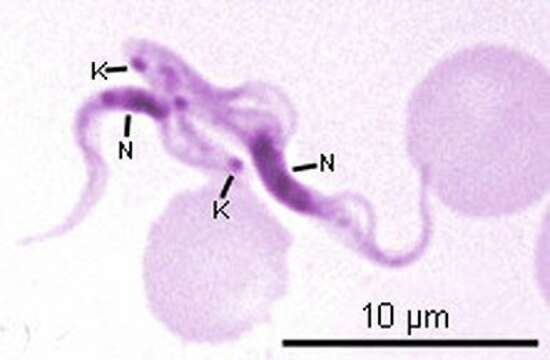Giemsa

Description:
Trypanosoma Gruby, 1843. Digenetic trypanosomatids (two hosts) with a trypomastigote form in the blood of the vertebrate host, a promastigote or choanomastigote form in the vector insect and an amastigote form inside macrophages and tissues of the vertebrate host. The cell of the trypomastigote form has one flagellum adherent to the entire length of the cell body. A kinetoplast is situated at the base of the insertion of the flagellum and the nucleus is posterior or median. The epimastigote form has one apical flagellum with a kinetoplast at its base and a central nucleus. Salivarian trypanosomes occur in the blood of vertebrates and are transmitted by an haematophagous insect such as the tsetse Glossina fly in African trypanosomiasis; salivarian trypanosomes are transmitted by contamination by the feces of the insect vector such as the Rhodnius bug in American trypanosomiasis or Chagas disease. This image of Trypanosoma congolense, trypomastigote form in blood of humans (Giemsa staining).
Included On The Following Pages:
- Life (creatures)
- Cellular (cellular organisms)
- Eukaryota (eukaryotes)
- Excavates (excavates)
- Discoba (Jakobids)
- Euglenozoa
- Kinetoplastea
- Trypanosomatidae (trypanosomes)
- Trypanosoma
- Nannomonas
- Trypanosoma congolense
This image is not featured in any collections.
Source Information
- license
- cc-by-nc
- author
- Guy Brugerolle
- provider
- micro*scope
- original
- original media file
- visit source
- partner site
- micro*scope
- ID


